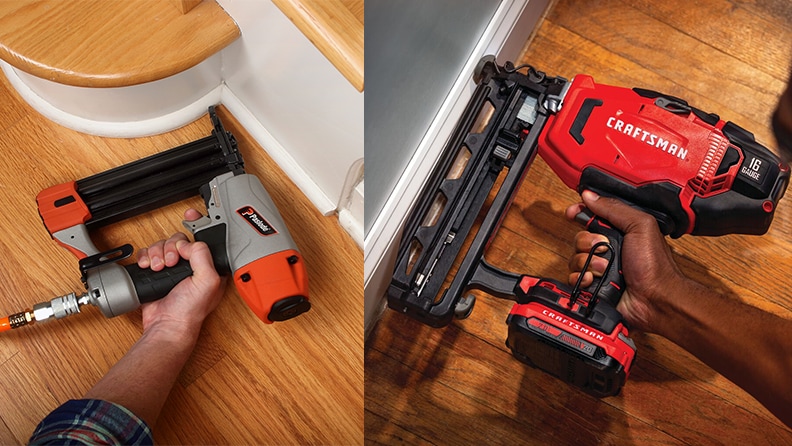When it comes to finishing nailers, two of the most popular sizes are 15 gauge and 16 gauge. Both offer different advantages that make them better suited for specific applications, But how would you know if a 15 vs 16 gauge finish nailer is the right choice for your project?
It’s always a good idea to make sure you have the right tool for the right job. Finish nailers are very powerful and can put a lot of force behind the nail, so choosing the right size for your project is important.

Finish nailers are divided into two versions by their magazine style. One is angled and the other is called a straight finish nailer. There are some subtle differences between angled and straight-finish nailers.
The main difference between 15 gauge and 16 gauge is size. 15-gauge nails are thicker than 16-gauge nails and therefore stronger. They also offer more holding power for heavier objects such as hardwood flooring.
15 Gauge Finish Nailer

So the first nailer we have is the 15g finish nailer. This type of nailer is ideal for heavier applications such as hardwood flooring or other heavy materials. The 15-gauge nails are thicker and stronger, so they can hold up to more weight without bending or breaking.
Thanks to the thickness of the nails, they are also able to penetrate further into the material you’re nailing. This makes them excellent for applications such as framing or siding where you need more power and penetration.
These nailers also have a bigger head that generates more holding power. So if you are working with trimming the exterior (or even interiors) then the 15-gauge nailer is an excellent tool for the job.
However, if you are working with more delicate works such as molding or trimming thin baseboards, the 15g Finish nailer can split the wood. This is why it’s important to make sure you have the right tool for the job before you start.
16 Gauge Finish Nailer

Now when it comes to 16g finish nailers, they are ideal for lighter materials such as molding and trim pieces. The 16-gauge nails are thinner than their 15-gauge counterparts, so they won’t split or damage the wood when driven in.
They offer less holding power but still enough to get the job done. In addition, these nailers have a smaller head which decreases the risk of splitting thin pieces of wood.
So if you are working with lighter materials such as baseboards or trim, the 16-gauge nailer is likely a better choice.
These nailers are quite versatile so you can use them for a wide range of applications. From crown molding to baseboards, the 16-gauge nailer can handle it all.
Comparing 15 vs 16 Gauge Finish Nailer- Key Differences
So now that we know what a 15g and 16g finish nailer is, let’s take a look at the key differences between them.
Nail Size
The first and most important difference is the size of the nails. 15g nails are thicker and stronger than 16g nails, so they offer more power and holding capacity.
A typical 15-gauge nail is 1 ¼″ up to 2 ½″ long and has a thickness of 0.072″.
In contrast, 16-gauge nails are thinner and shorter. They can range from 1 ¼″ up to 2 ¼″ long with a thickness of 0.062″. As you can see, the 15-gauge nail is the bigger one here.
Head Size
The 15g nailer has a larger head that gives it more holding power while the 16g nailer has a smaller head which reduces the risk of splitting thin pieces of wood.
It mainly depends on the material you are working with as to which one is better.
Holding Power
Thanks to the larger nails, the 15g finish nailer offers more holding power. 15-gauge nails are larger and have a larger head than 16-gauge nails.
The larger the head, the more surface area there is for the adhesive to bond to, which in turn increases the holding power.
A 15-gauge finish nailer will drive nails that are larger in diameter and longer than a 16-gauge finish nailer, which results in a stronger hold.
This makes a 15-gauge finish nailer more suitable for heavy-duty tasks such as framing, sheathing, and installing flooring.
On the other hand, a 16-gauge finish nailer is more delicate, precise, and suitable for tasks such as trim work, crown molding, and baseboards. They have a smaller head size and produce less damage to the wood surface.
Versatility
When it comes to versatility both nailers are very capable. The 15g is great for heavier materials while the 16g is better suited to lighter applications.
But since there are lighter materials than heavier ones, the 16g can be used for a wider range of applications.
However, if you are looking for more versatility, you can go with 18g nailers rather than a 16g nailer (depending on the project of course).
Power
When it comes to power and penetration, the 15g finish nailer packs more punch than the 16g. The thicker nails can penetrate further into the material while still providing enough holding power.
However, more power means more damage to the material, so you need to make sure you have the right tool for the job.
Price
When it comes to the price, it depends on a few things! For example, whether you are using a pneumatic or cordless nailer, the brand and quality of the nailer will all have an impact on the overall cost.
Cordless finish nailers, however, are a bit pricier than pneumatic nailers. That being said, typically a 15g nailer will be slightly more expensive than a 16 g nail due to the thicker nails and higher power output.
Weight
It only makes sense that a 15g nailer will be heavier than a 16g due to the thicker nails and higher power output.
15g nailers use more air pressure and can be heavier than their 16g counterparts, so they may not be the best choice if you are looking for a lightweight nailer.
Here’s an overview of the comparison highlighting the main differences between these two tools:
| Feature | 15 ga finish nailer | 16 ga finish nailer |
| Nail Size | Thicker and stronger; 1 ¼″ to 2 ½″ long; thickness: 0.072″. | Slightly thinner and shorter; 1 ¼″ to 2 ¼″ long; thickness: ~0.062″. |
| Head Size | Larger head | Smaller head |
| Holding Power | Higher holding power due to thicker and longer nails. | Low holding power but more precise. |
| Versatility | Versatile for heavy materials. | Wide range of versatility for lighter materials. |
| Power | More power and penetration. | Less power. |
| Price | More expensive due to thicker nails and higher power output. | Less expensive than 15g. |
| Weight | Heavier | Lighter |
When to Use a 15 Gauge Finish Nailer?

A 15 gauge finish nailer is perfect for heavy duty tasks that need strength, durability, and excellent holding power.
Here are the main situations where it works best:
- Thick or Heavy Baseboards
The thicker 15 gauge nails provide strong holding power, making them ideal for securing large baseboards that need extra support. - Crown Molding and Large Trim
This nailer is great for installing wide trim or crown molding, especially with hardwood or dense materials. The larger nails keep heavy trims firmly in place. - Door Frames and Window Jambs
A 15-gauge finish nailer is perfect for attaching door frames and window jambs since it can handle the extra weight and pressure these structures face. - Hardwood Flooring
It can be used for tongue and groove hardwood flooring installations, providing the stronger hold needed for secure placement. - Staircases
For building or repairing staircases, this nail gun ensures stability and safety with its superior holding power. - Cabinets and Furniture (Heavy Duty)
This tool is ideal for assembling large, heavy furniture or cabinetry where extra strength is necessary for structural stability. - Exterior Trim and Siding
A 15 gauge finish nail gun works well for exterior trim or siding projects, as the nails are designed to endure weather and temperature changes. - Projects Requiring Strong Adhesion
For projects involving glue, the larger nail head of a 15 gauge finish nailer provides a better surface area for adhesives. It ensures strong and longer bonding.
When to Use a 16-Gauge Nailer

A 16-gauge finish nailer is a versatile tool that works well for medium duty projects.
Here are some common situations where it’s a great choice:
- Baseboards & Crown Molding
This ga finish nailer provides enough strength to secure baseboards and crown molding while reducing the chance of splitting the wood. Its smaller nails leave a smooth, professional finish. - Door & Window Casings
The thinner nails are ideal for attaching casings without damaging or splitting delicate trim pieces. - Chair Rails and Wainscoting
16-gauge finish nailers work well for installing chair rails and wainscoting panels. It offers a good mix of precision and holding power. - Lightweight Furniture Assembling
This finish nailer is suitable for assembling furniture made from softer woods or MDF. The nails provide enough strength without over penetrating or causing damage. - Cabinets and Drawers
It’s a reliable choice for building or installing cabinets and drawers. It ensures components are secured while maintaining a clean look. - Trim Work
Perfect for attaching trim and molding, as the smaller nails leave tiny holes that are easier to fill for a neat finish. - Medium Duty Projects
A 16-gauge nailer is dependable for medium-duty tasks like paneling or casing. It balances power and precision for a wide range of projects.
Pro Tips for Choosing the Right Finish Nailer
- Match the Nailer to Your Project
Think about the material, thickness, and type of work you’re planning for. This will easily help you decide whether a 15-gauge or 16-gauge nailer is better for your needs. - Check Your Budget
A 15-gauge nailer offers more power. But it is often more expensive. Decide what fits your budget while keeping your project requirements in mind. If you are a beginner or an occasional user then go for 15 ga. - Consider Portability
If you need to move frequently for a project, a lightweight 16-gauge nailer might be easier to handle. - Choose Between Cordless and Pneumatic
Cordless nailers are portable and convenient but tend to cost more. Pneumatic nailers are more affordable but need an air compressor to operate.
16 vs 15 Gauge Finish Nailer – Which Nailer is Better?
There is no simple answer to this question as it depends on the type of project you are working on. Both nailers have their pros and cons, so you need to decide which one is best suited for your needs.
If you’re looking for a nailer that offers more power and holding capacity, then go with the 15g finish nailer.
On the other hand, if you are looking for a lightweight nailer with less power and the risk of damaging the material, then go with the 16g finish nailer.
It only comes down to deciding which one is best for the job. So make sure you do your research and read up on the material you are working with as to which one is better.
No matter which one you choose, make sure you always use safety gear when working with any type of nailer.
Overall, both 15g and 16g finish nailers are great tools to have in your arsenal. Be sure to weigh the pros and cons of each before purchasing one!
Final Verdict on 15 gauge vs 16 gauge Finish Nailer
There is no definitive winner in the 15 vs. 16-gauge finish nailer debate. The best choice depends on your project requirements.
Here’s a quick summary to help you decide:
| Feature | 15 ga finish nailer | 16 ga finish nailer |
| Nail Thickness | 0.072” | 0.062” |
| Nail Length | 1 1/4” to 2 1/2” | 1 1/4” to 2 1/4” |
| Power | High | Moderate |
| Weight | Heavier | Lighter |
| Price | Heavier | Lower |
If you’re tackling heavy duty projects that need thicker, longer nails and extra power, go for a 15-gauge finish nailer.
In contrast, if you’re working on lighter finishing tasks and want something more affordable and easier to handle, a 16-gauge finish nailer is a better fit.
Picking the right tool for the job makes all the difference and helps you get professional-looking results every time.
FAQs
1. Can you use 16g nails in a 15g nailer?
Ans: No, you can’t use 16-gauge nails in a 15-gauge nailer. These nailers are designed to work with specific nail sizes, and the two gauges are not interchangeable.
If you somehow try to do this, then it will cause tool damage, poor performance, and ineffective results.
2. Which nailer is better for crown molding?
Ans: A 16 gauge finish nailer is ideal for crown molding as it’s lightweight, precise, and less likely to split the wood.
3. Can I use both 15 and 16-gauge finish nailers for furniture building?
Ans: Yes, but the 16 gauge is more suitable for furniture building due to its thinner nails causing less visible damage.
4. Are 15 gauge finish nailers harder to maintain than 16 gauge nailers?
Ans: No, the maintenance requirements are similar for both types of nailers.
5. Which Nailer Causes Fewer Blowouts, a 15 gauge or 16 gauge?
Ans: 16-gauge nailers usually cause fewer blowouts because their thinner nails are less aggressive. This makes it a better choice for more delicate materials or when you want to avoid splitting the wood.

